#Chrysler Europe
Text
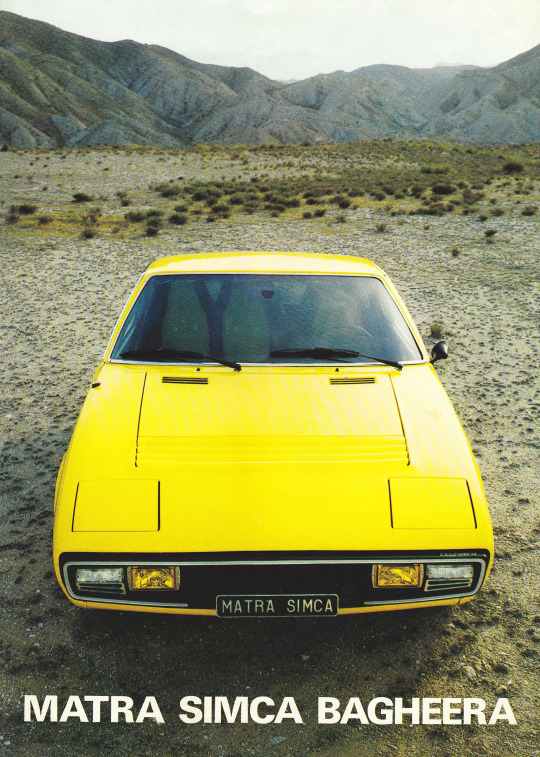


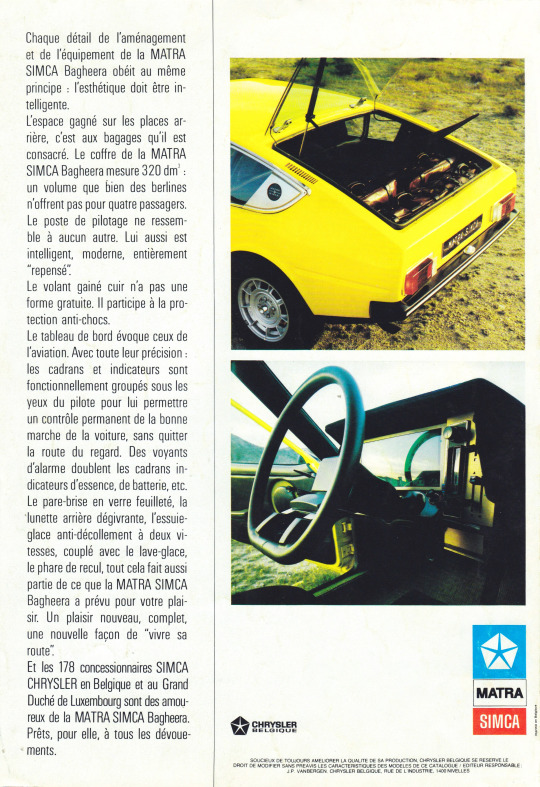
Matra Simca Bagheera brochure, 1974. A mid-rear engined sports car built by Matra for Simca/Chrysler Europe using the transverse drivetrain from the Simca 1100 moved to the rear wheels. The Bagheera's USP was the 3-seat configuration with the driver on the left. There was a sexist French joke that claimed the car was designed so that driver would have space for both his wife and his mistress.
#Matra#Matra Simca Bagheera#1974#brochure#Chrysler Europe#mid-rear engine#3 seater#sports car#coachbuilt#dead brands#1970s
190 notes
·
View notes
Text
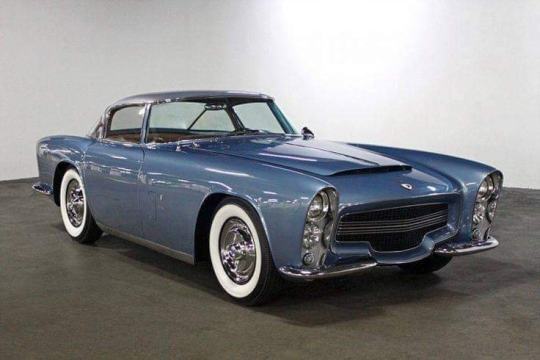
1953 Dodge ‘Zeder’ Storm Z-250
1953 Dodge ‘Zeder’ Storm Z-250 Concept with body by Bertone
One-off
The Storm Z-250 was developed by Chrysler engineer Fred Zeder to evaluate the feasibility of producing a vehicle that would capture a portion of the growing American sports car market.
Built on a rigid tube frame chassis (built mostly by Chrysler engineer, John Butterfield, in his basement), it was intended to be a dual-purpose sports/racing car because Zeder Jr. envisioned a car with swappable bodies.
In 1952, while on Christmas vacation in Europe, Zeder visited Fiat's Chief Engineer in Turin.
Dante Giacosa recommended a visit to Bertone.
Though they were busy designing and building the Alfa Romeo BAT series, they agreed to build the body for Zeder's new car and promised three months to finish the car.
It took nine months to finish.
Unique to the Storm Z-250 was that the comfortable ‘touring’ body could be removed by unscrewing four bolts and replaced with an ultralight 150-pound fiberglass body for ‘racing’.
The mechanical components of the car included a Dodge hemi V8 truck engine with 260hp and 330ft-lbs of torque.
Other parts came from Plymouth and Dodge vehicles, including brakes, radiator, clutch, fuel tank, rear axle, and the steering system.
The transmission was a new unit developed by the Spicer Division of Dana Corporation.
The Storm did not reach the assembly line because high production costs would have made it too expensive to sell in profitable quantities.
The Z-250 would have competed with the Ford Thunderbird, Chevrolet Corvette, and the Kaiser-Darrin.
Zeder drove the Z-250 for 16 years.
He loaned it to the Northwood University where it remained until 1992.
Unfortunately, water leaked into the cylinders so the engine was removed and replaced with a 1965 Dodge V8 with two four-barrel carburetors.
After the work was completed, Zeder continued to drive the car in his home in California.
#Dodge ‘Zeder’ Storm Z-250#Dodge ‘Zeder’#Dodge#Storm Z-250#car#cars#mopar#moparperformance#moparnation#moparworld
128 notes
·
View notes
Text
It would take Diane Joyce nearly ten years of battles to become the first female skilled crafts worker ever in Santa Clara County history. It would take another seven years of court litigation, pursued all the way to the U.S. Supreme Court, before she could actually start work. And then, the real fight would begin.
For blue-collar women, there was no honeymoon period on the job; the backlash began the first day they reported to work—and only intensified as the Reagan economy put more than a million blue-collar men out of work, reduced wages, and spread mounting fear. While the white-collar world seemed capable of absorbing countless lawyers and bankers in the 80s, the trades and crafts had no room for expansion. "Women are far more economically threatening in blue-collar work, because there are a finite number of jobs from which to choose," Mary Ellen Boyd, executive director of Non-Traditional Employment for Women, observes. "An MBA can do anything. But a plumber is only a plumber." While women never represented more than a few percentage points of the blue-collar work force, in this powder-keg situation it only took a few female faces to trigger a violent explosion.
Diane Joyce arrived in California in 1970, a thirty-three-year-old widow with four children, born and raised in Chicago. Her father was a tool-and-die maker, her mother a returned-goods clerk at a Walgreen's warehouse. At eighteen, she married Donald Joyce, a tool-and-die maker's apprentice at her father's plant. Fifteen years later, after working knee-deep in PCBs for years, he died suddenly of a rare form of liver cancer.
After her husband's death, Joyce taught herself to drive, packed her children in a 1966 Chrysler station wagon and headed west to San Jose, California, where a lone relative lived. Joyce was an experienced bookkeeper and she soon found work as a clerk in the county Office of Education, at $506 a month. A year later, she heard that the county's transportation department had a senior account clerk job vacant that paid $50 more a month. She applied in March 1972.
"You know, we wanted a man," the interviewer told her as soon as she walked through the door. But the account clerk jobs had all taken a pay cut recently, and sixteen women and no men had applied for the job. So he sent her on to the second interview. "This guy was a little politer," Joyce recalls. "First, he said, 'Nice day, isn't it?' before he tells me, 'You know, we wanted a man.' I wanted to say, 'Yeah, and where's my man? I am the man in my house.' But I'm sitting there with four kids to feed and all I can see is dollar signs, so I kept my mouth shut."
She got the job. Three months later, Joyce saw a posting for a "road maintenance man." An eighth-grade education and one year's work experience was all that was required, and the pay was $723 a month. Her current job required a high-school education, bookkeeping skills, and four years' experience— and paid $150 less a month. "I saw that flier and I said, ‘Oh wow, I can do that.’ Everyone in the office laughed. They thought it was a riot. . . . I let it drop."
But later that same year, every county worker got a 2 to 5 percent raise except for the 70 female account clerks. "Oh now, what do you girls need a raise for?" the director of personnel told Joyce and some other women who went before the board of supervisors to object. "All you'd do is spend the money on trips to Europe." Joyce was shocked. "Every account clerk I knew was supporting a family through death or divorce. I'd never seen Mexico, let alone Europe." Joyce decided to apply for the next better-paying "male" job that opened. In the meantime, she became active in the union; a skillful writer and one of the best-educated representatives there, Joyce wound up composing the safety language in the master contract and negotiating what became the most powerful county agreement protecting seniority rights.
In 1974, a road dispatcher retired, and both Joyce and a man named Paul Johnson, a former oil-fields roustabout, applied for the post. The supervisors told Joyce she needed to work on the road crew first and handed back her application. Johnson didn't have any road crew experience either, but his application was accepted. In the end, the job went to another man.
Joyce set out to get road crew experience. As she was filling out her application for the next road crew job that opened, in 1975, her supervisor walked in, asked what she was doing, and turned red. "You're taking a man's job away!" he shouted. Joyce sat silently for a minute, thinking. Then she said, "No, I'm not. Because a man can sit right here where I'm sitting."
In the evenings, she took courses in road maintenance and truck and light equipment operation. She came in third out of 87 applicants on the job test; there were ten openings on the road crew, and she got one of them.
For the next four years, Joyce carried tar pots on her shoulder, pulled trash from the median strip, and maneuvered trucks up the mountains to clear mud slides. "Working outdoors was great," she says. "You know, women pay fifty dollars a month to join a health club, and here I was getting paid to get in shape." The road men didn't exactly welcome her arrival. When they trained her to drive the bobtail trucks, she says, they kept changing instructions; one gave her driving tips that nearly blew up the engine. Her supervisor wouldn't issue her a pair of coveralls; she had to file a formal grievance to get them. In the yard, the men kept the ladies' room locked, and on the road they wouldn't stop to let her use the bathroom. "You wanted a man's job, you learn to pee like a man," her supervisor told her.
Obscene graffiti about Joyce appeared on the sides of trucks. Men threw darts at union notices she posted on the bulletin board. One day, the stockroom storekeeper, Tony Laramie, who says later he liked to call her "the piglet," called a general meeting in the depot's Ready Room. "I hate the day you came here," Laramie started screaming at Joyce as the other men looked on, many nodding. "We don't want you here. You don't belong here. Why don't you go the hell away?"
Joyce's experience was typical of the forthright and often violent backlash within the blue-collar work force, an assault undisguised by decorous homages to women's "difference." At a construction site in New York, for example, where only a few female hard-hats had found work, the men took a woman's work boots and hacked them into bits. Another woman was injured by a male co-worker; he hit her on the head with a two-by-four. In Santa Clara County, where Joyce worked, the county's equal opportunity office files were stuffed with reports of ostracism, hazing, sexual harassment, threats, verbal and physical abuse. "It's pervasive in some of the shops," says John Longabaugh, the county's equal employment officer at the time. "They mess up their tools, leave pornography on their desks. Safety equipment is made difficult to get, or unavailable." A maintenance worker greeted the first woman in his department with these words: "I know someone who would break your arm or leg for a price." Another new woman was ordered to clean a transit bus by her supervisor—only to find when she climbed aboard that the men had left a little gift for her: feces smeared across the seats.
In 1980, another dispatcher job opened up. Joyce and Johnson both applied. They both got similarly high scores on the written exam. Joyce now had four years' experience on the road crew; Paul Johnson only had a year and a half. The three interviewers, one of whom later referred to Joyce in court as "rabble-rousing" and "not a lady," gave the job to Johnson. Joyce decided to complain to the county athrmative action office.
The decision fell to James Graebner, the new director of the transportation department, an engineer who believed that it was about time the county hired its first woman for its 238 skilled-crafts jobs. Graebner confronted the roads director, Ron Shields. "What's wrong with the woman?" Graebner asked. “I hate her," Shields said, according to other people in the room. "I just said I thought Johnson was more qualified," is how Shields remembers it. "She didn't have the proficiency with heavy equipment." Neither, of course, did Johnson. Not that it was relevant anyway: dispatch is an office job that doesn't require lifting anything heavier than a microphone.
Graebner told Shields he was being overruled; Joyce had the job. Later that day, Joyce recalls, her supervisor called her into the conference room. "Well, you got the job," he told her. "But you're not qualified." Johnson, meanwhile, sat by the phone, dialing up the chain of command. "I felt like tearing something up," he recalls later. He demanded a meeting with the affirmative action office. "The affirmative action man walks in," Johnson says, "and he's this big black guy. He can't tell me anything. He brings in this minority who can barely speak English . . . I told them, 'You haven't heard the last of me.'" Within days, he had hired a lawyer and set his reverse discrimination suit in motion, contending that the county had given the job to a "less qualified" woman.
In 1987, the Supreme Court ruled against Johnson. The decision was hailed by women's and civil rights groups. But victory in Washington was not the same as triumph in the transportation yard. For Joyce and the road men, the backlash was just warming up. "Something like this is going to hurt me one day," Gerald Pourroy, a foreman in Joyce's office, says of the court's ruling, his voice low and bitter. He stares at the concrete wall above his desk. "I look down the tracks and I see the train coming toward me."
The day after the Supreme Court decision, a woman in the county office sent Joyce a congratulatory bouquet, two dozen carnations. Joyce arranged the flowers in a vase on her desk. The next day they were gone. She found them finally, crushed in a garbage bin. A road foreman told her, "I drop-kicked them across the yard."
-Susan Faludi, Backlash: the Undeclared War Against American Women
#susan faludi#female oppression#male entitlement#male violence#blue collar#women’s work#pay gap#sexism#misogyny#womens history#us history#amerika
85 notes
·
View notes
Photo


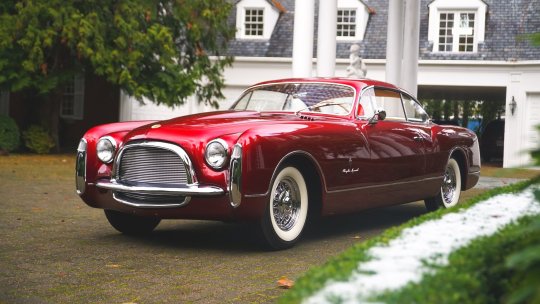
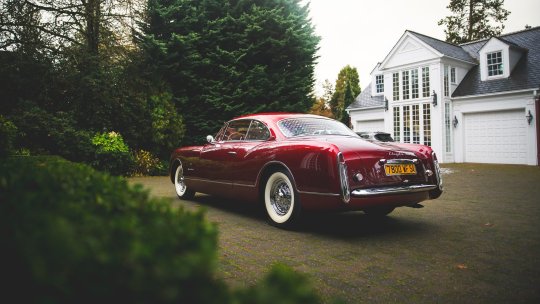


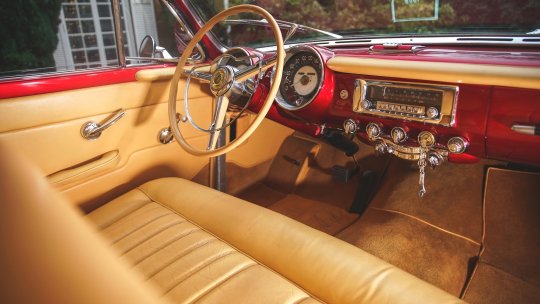


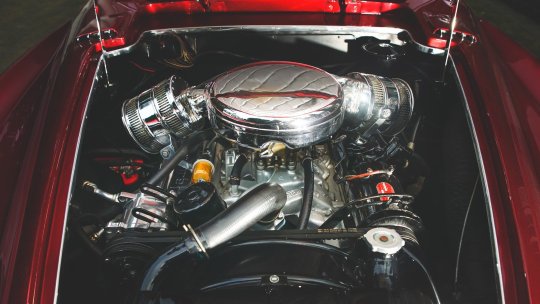
Chrysler Special Coupé by Ghia (1 of 19).
One of the first Chrysler show cars designed by Virgil Exner and built by Italian coachbuilder Ghia, the appropriately named Chrysler Special was first exhibited at the Paris Salon in October 1952. Built on a New Yorker chassis shortened by six inches, it featured unusually high radiused wheel arches that extended almost to the top of the fenders, smooth sides that flowed from bumper to bumper with only a small “kick” in the rear fender curve, rounded headlights, and a broad chromed trapezoidal grille.Its subtle yet muscular lines made the Special the hit of the show, and M. Ladouch, proprietor of the French Chrysler importers France Motors, realized that there was a willing market for a small number of copies, for which he secured the support of Chrysler export manager C.B. Thomas.Ghia’s “production” Chrysler Special was based upon the original show car but built upon a standard-wheelbase, 125.5-inch New Yorker platform and with a modified semi-fastback roofline to accommodate four full-sized adults. The first of these limited-production, hand-built cars was made for C.B. Thomas himself, and was followed by another 18 cars, six for customers of France Motors and another dozen for clients of Ghia. All were originally delivered in Europe. American customers, in many cases—with the exception of the fortunate Mr. Thomas—remained unaware that this truly “special” Chrysler even existed until a few of the cars made their way stateside later in life. Nonetheless, this “dream car for the public” can be seen as the forerunner of similar efforts to follow later in the 1950s, most prominently the Dual Ghia.
259 notes
·
View notes
Text



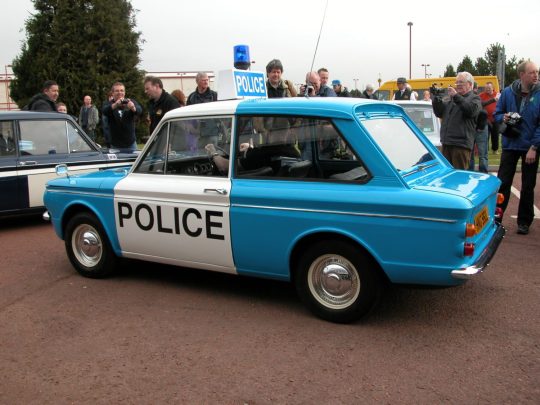
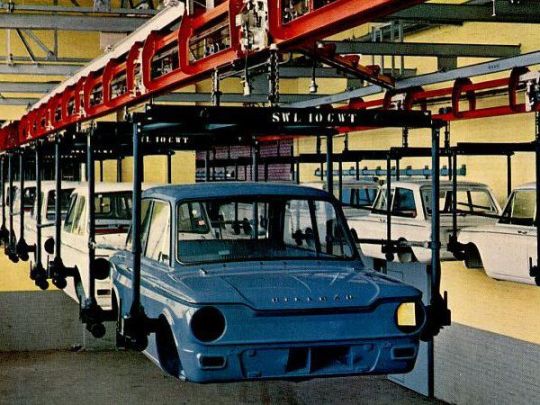
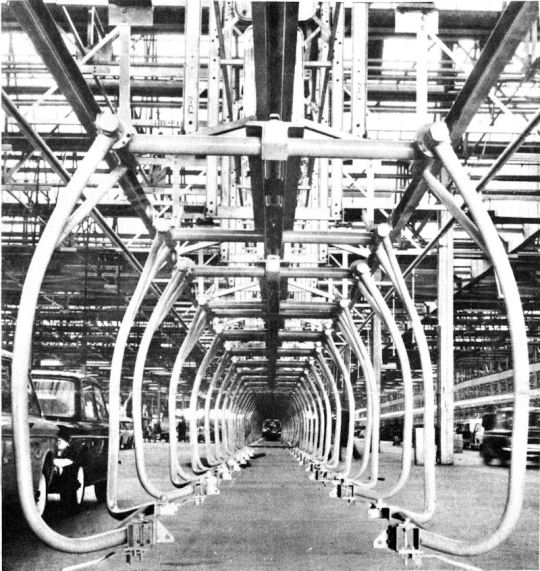
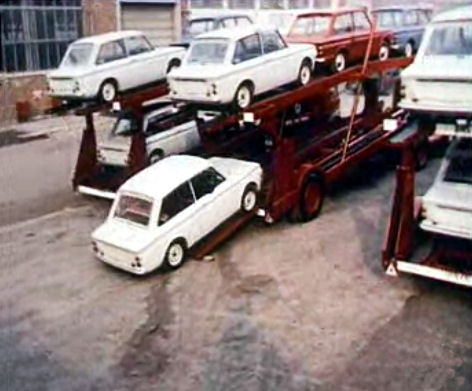
On 2nd May 1963 The Rootes Car Factory opened at Linwood it went on to produce Scotland's answer to the Mini, the Imp.
The Hillman Imp is a compact, rear-engined saloon car that was manufactured under the Hillman marque by the Rootes Group (later Chrysler Europe) from 1963 to 1976.
Linwood underwent a number of ownership changes, passing first to American brand Chrysler before winding down in the late 1970s and early 1980s under Peugeot-Talbot.
Compact models were very much in vogue after the 1956 Suez Crisis, and the Hillman Imp, while never quite able to match the Mini, sold relatively well - especially in Scotland, where buyers took pride by the knowledge that it was the first car to be built here in over 35 years.
With an 875cc rear-mounted engine tilted at an accessible 45 degree angle, the wee motor could reach 0 to 50 in just under 15 seconds and boasted top speeds approaching 80 miles per hour.
Popular variants included the Sunbeam Stiletto, the Californian, the esate-sized Hillman Husky, and the most exquisite of all, the Singer Chamois. Hillman Imps were even favoured by Dunbartonshire Police, who first adopted the car in 1967.
The car was also celebrated for its cutting-edge design principles and quirky features. There were fold-back seats, indicators, stalk controls for the windscreen wipers and the rear window opened.
Above all, though, with a launch price of £500, the Imp represented great value for money - or so it first appeared.
Thanks to a host of internal design flaws, which included an inadequate cooling system, poor steering, gearbox and clutch problems, faulty chokes and a tendency to leak water, the Hillman Imp developed a reputation for unreliability. Break-downs became a common occurrence for Imp owners, with the car’s main saving grace being that it was generally easy to fix, provided you knew what you were doing.
After 18 years and 450,000 vehicles manufactured, Linwood was no more.
On February 11th 1981 6,000 employees at the Linwood car plant were told their services were no longer required. The firm which had given the world the Hillman Imp had gone to the wall, putting an end to car production in Scotland for good.
13 notes
·
View notes
Text
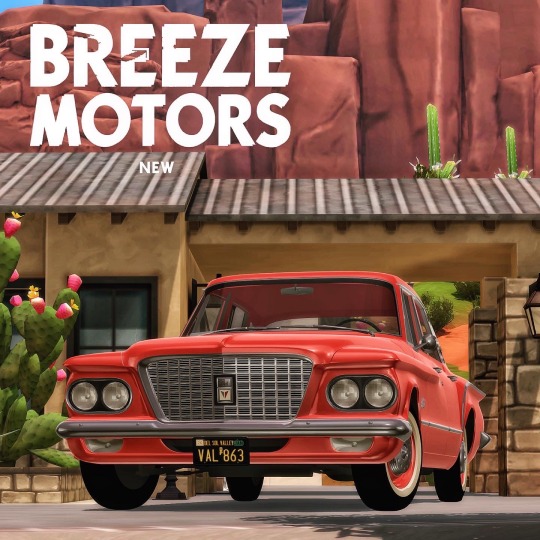
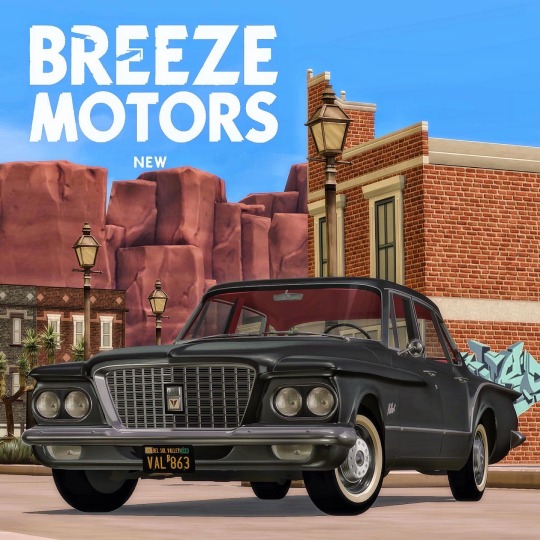
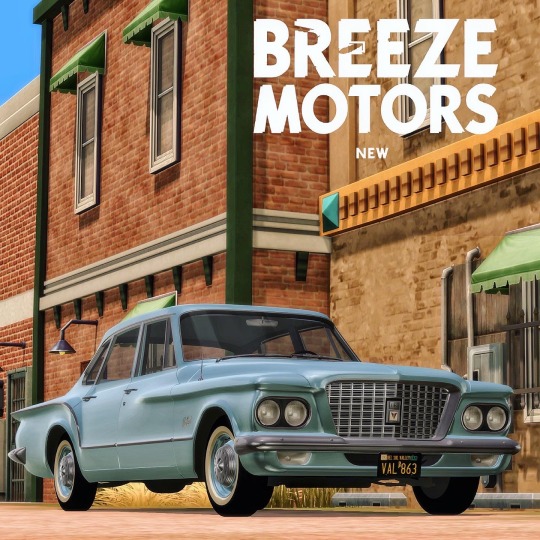

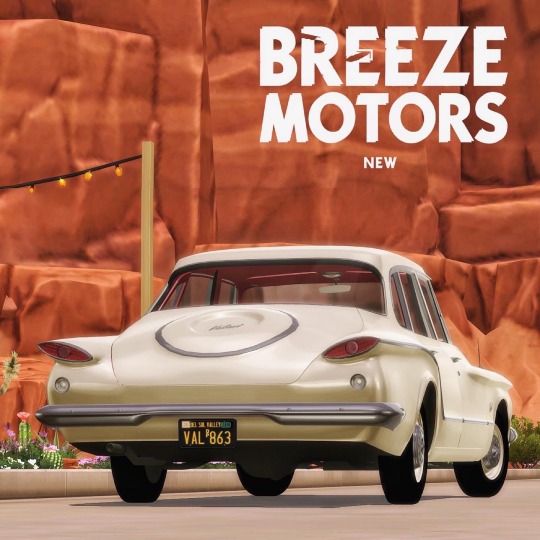

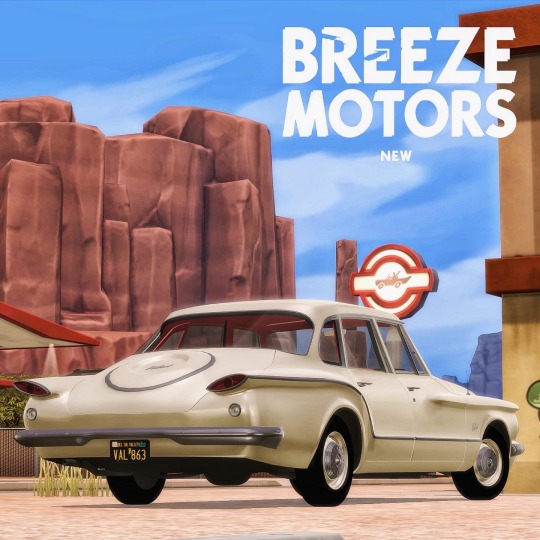

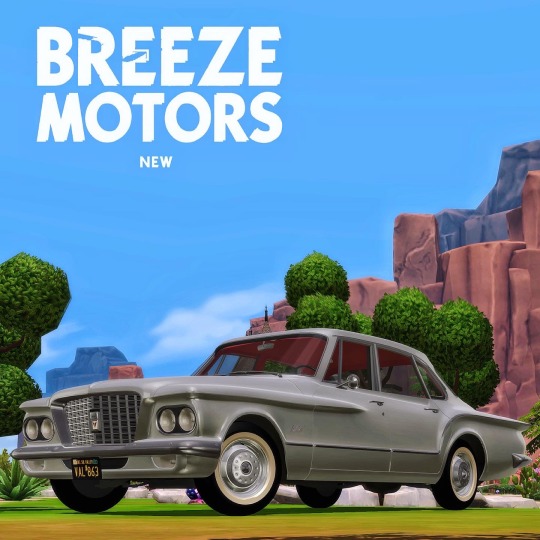
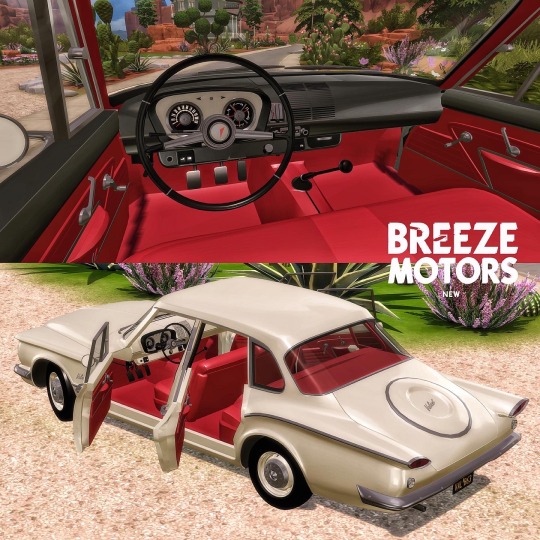
“Radical Styling”
1960 Plymouth Valiant 🇺🇸
Plymouth introduced the Valiant line in 1960 as a new compact entry-level model. For this year only, Chrysler management brought the Valiant to market as its own brand, but eventually settled on Plymouth even though the car was actually built by Dodge.
When they were launched, the 1960 Valiants were the best a mighty Chrysler Corporation could do. With alternators only recently wrung out of the space program, a hot new engine - Chrysler’s first new six-cylinder since the war - and radical Virgil Exner styling, the Valiant was even one of the first cars to be developed with the help of computers. With the Valiant, Chrysler was ready to re-conquer Europe and other lands, not to mention attack a new segment of the domestic car market.
Available exclusively for “No Limits” and “All Inclusive” tiers.
Model with HQ interior, open/close doors and functional light.
Go and join my Patreon!
#the sims 4#sims 4#sims4#sims4car#the sims 4 cc#the sims 4 custom content#thesims4cars#the sims 4 cars#sims4vehicles#the sims#the sims 4 cc finds#sims 4 cc finds#the sims 5#sims 4 cars#sims 5#sims 4 cc#the sims custom content#sims 4 alpha cc#sims
20 notes
·
View notes
Text
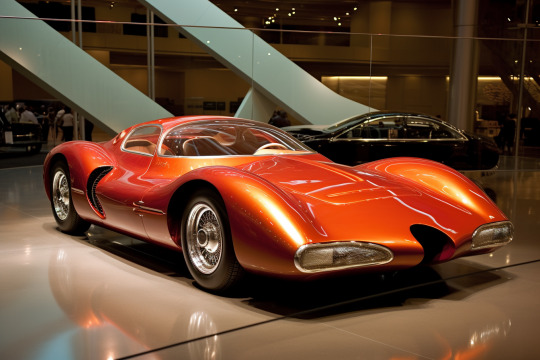
The 1966 Chrysler-Ghia Turbina, shown on display in the MotorWorld-Heritage museum, in Geneva, Switzerland, is an one-off concept car built after the success of the Chrysler Turbine Car in 1963. It was built to be as exotic as possible, showing off to Europe the future of automobile power. Using the same A-831 Gas Turbine as the Turbine Car, it would be driven and tested at a few race tracks, given a new, Chrysler-Built 4 speed automatic transmission, rather than the Torqueflite of it's predecessor. Two cars were planned, but the second car, body complete, without engine or suspension, was lost in transit from Turin to Detroit in a dockyard fire. T-1 was first paraded at the 1965 Motorworld Show in Bonn, West Germany to critical applause and intrigue, showing off the power of Chrysler's advanced turbine engine, beginning Chrysler's evolution from a traditional manufacturer, to one who produced more advanced, more expensive products in the mid-to-late 20th century, shifting their dynamic to produce things like a production Turbine car in 1971.
12 notes
·
View notes
Text
In the continued saga of Car Noticing (previously I noticed Kazuki's car is a Renault), this week on Buddy Daddies I noticed the car of the guy Rei went out killin' with.
It's literally a Chrysler 300

There's definitely someone on the show staff who is a Car Knower! But I find this one an odd choice because it's a right hand drive Chrysler 300. Granted, they did sell the 300 in Europe for a while, including rebadging it as a Lancia Thema. But that stopped in 2019.
And anyway, I think a Lexus or Toyota sedan would be a much better choice for the high-class assassins of Japan. More reliable than a Chrysler, anyway.
15 notes
·
View notes
Text
How Peugeot Caused an Advertising Stampede
In this series, Squideo has examined the best ways to turn advertising content into gold. Now that we’ve broken down the eight key ingredients, it’s time to dive deep into some examples of stellar advertising. This week, the advert in question was picked by Squideo’s Account Director, Adam Shelton.
When asked why this Peugeot advert had become his favourite, Adam said: “It accomplished everything an advert is meant to. It’s memorable, it’s unique and it keeps the product front and centre. Plus the bit with the elephant is hilarious.”

The Peugeot Roars
You don’t need to be a driver to have heard of Peugeot. You’ll have encountered this French brand from buying your first bicycle to equipping your kitchen. Peugeot was founded in 1810 – over 200 years’ ago – by the Peugeot family who retained majority shares in the automotive company until 2014. Peugeot manufactured a vast variety of products in its early years, from hand-held saws to pepper grinders.
Eventually they branched out into bicycle production, car manufacturing and motorcycle making. Amazingly, they still continue to make kitchen tools under Peugeot Saveurs. Cycles Peugeot and Peugeot Motorcycles are also still on the go, and they make vehicles for motor racing events under Peugeot Sport. Up until 1986, they even had their own cycling team which won ten titles at the Tour de France.
Like many car manufacturers, Peugeot have acquired other brands and ownership of this company has changed hands repeatedly. In the 20th century, Peugeot took over Hotchkiss, Chenard-Walcker, Citroën and Chrysler Europe. As of 2021, Peugeot is owned by Stellantis – a multinational automotive manufacturing corporation which was created after the merger of major American, French and Italian manufacturers. A member of the Peugeot family is part of Stellantis’ senior management, demonstrating the power and influence Peugeot has built and maintained since 1810.

2 Fast 2 Peugeot
Created by Euro RSCG of Milan-Italy, The Sculptor was released in 2003 to critical acclaim – winning numerous international awards. The car promoted in the advert, the Peugeot 206, was released in 1998 as a replacement of the 205 model. Within ten years, the 206 had become Peugeot’s best-selling car.
The advert was so popular that fifteen years later the BBC show Top Gear recreated it in celebration of the Peugeot 206’s anniversary. On its twentieth anniversary, Peugeot also released a recreation of the advert with the Peugeot 208 replacing the 206. To accomplish this, several months were spent at Ajeenkya D Y Patil University in 2002 where engineers painstakingly converted the Hindustan Ambassador.
In the advert, a motorist turns his Ambassador – an iconic Indian car that started life as a Morris Oxford – into a Peugeot 206. Directed by Matthijs van Heijningen Jr., who has since gone on to become the director of Netflix’s first Dutch film, The Sculptor is considered one of the best car adverts of all time.
According to the award-winning Creative Director Adrian Holmes:
“A film I’ve always loved is a commercial for the Peugeot 206 called ‘The Sculptor’, made by Euro RSCG Milan in 2002. You must know the one – the young Indian guy who gets an elephant to sit on his old jalopy (amongst other methods) so that it ends up looking like the car of his dreams. Everything about it – the story, the editing, the music, the casting – is simply frame perfect. Apart from anything else, it stands as a monument to the brave and imaginative client who said ‘yes’ to such a wonderful and daring piece of work.”
Peugeot Rides Again
The 206 went on to be Peugeot’s best-selling model of all time, and one of the most popular cars ever made. Like the product, the advert selling it also swept the award boards in 2003: winning at the Cannes Lions International Festival of Creativity.
From the car’s release in 1998 to 2003, the year of The Sculptor’s release, sales of the Peugeot 206 increased by 146 percent. But why was The Sculptor such a big hit?
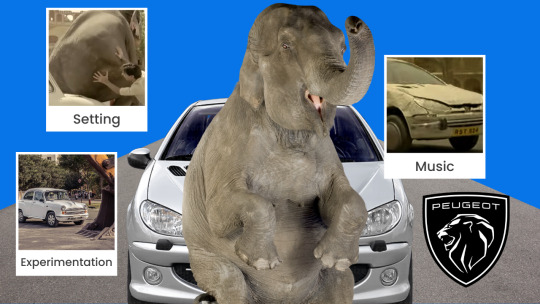
Real Renovations
The protagonist of the advert starts out with a Hindustan Ambassador and ends up with a Peugeot 206: the car of his dreams. The audience's expectation, after seeing the Ambassador destroyed, is that a pristine Peugeot 206 would be rolled out at the end. But that doesn’t happen. This car is dented, pummelled, bashed… there’s nothing pristine about it. Yet the protagonist still gets the attention of everyone who sees his new (old) car.
The fact that this advert really turned a Hindustan Ambassador into a Peugeot 206 is part of the reason this advert became so memorable. If they’d used CGI or switched out the car, the advert would have been like any other that uses a product swap.
International Intrigue
The name Peugeot forms an instant connection to its heritage: the brand is undeniably French. Setting the advert in French countryside or on Parisian streets would be predictable. Instead, The Sculptor is set in an Indian city. Why? To show that the car belongs anyway. Can be desired by anyone. It has international appeal.
The setting is also the home of the Hindustan Ambassador, India’s most popular car which was manufactured from 1957 to 2014 and called the “King of Indian Roads.” Once it fell out of production, the car became wildly collectable – but eleven years earlier in 2003 they were still easy to come by. A popular everyday car; much like the Peugeot 206. Stylistically, however, they’re worlds apart which is what made this a great before and after choice. The 206 was meant to be a new design for a new millennium, leaving behind the boxy style of the 20th century.
Mood Music
The advert plays to the song Heaven Is A Place On Earth by Raja Mushtaq, later remixed as Husan by Bhangra Knights. This bhangra dance song ended up charting, made it on Now That’s What I Call Music! 55, and sold over 20 million copies. Bhangra dance music is a non-traditional Punjabi music originating in British-Asian communities. It first emerged in the 1970s, seeing a resurgence in the 2000s that Peugeot got ahead of with its music choice.
This upbeat song only briefly appears after the protagonist successfully converts his Hindustan Ambassador into the Peugeot 206 and the non-traditional bhangra music symbolises the successful alteration of the vehicle.
Content Worth Gold
What do you think? What made Peugeot’s The Sculptor advert so successful? Watch the full advert below and let us know in the comments.
youtube
Get in touch with the Squideo team today to find out how we can improve your advertising strategy with video production, motion graphics, social media management and much more!
#peugeot#the sculptor#peugeot 206#marketing blog#elephant#youtube#2d animation#animation#marketing strategy#small business#small business on tumblr#marketing#advertising#advert alchemy#blog#Youtube
5 notes
·
View notes
Text
Project Z - chapter II
genre: horror, dystopia (viewer discretion advised)

"Live on CBC News, recent attempts at peace talks with the countries of Europe and South America are ending in failure, as both nations keep demanding huge sums of money as compensation for the sudden bombings in the regions of France and Brazil, where famous world monuments have been destroyed.
All the potential suspects have been traced back to prominent regions of North America, particularly in government strongholds. This has led all nations involved to suspect North America of committing such brazen crimes."
"You seeing this Ma?" Mykel asked while pacing around the living room restlessly.
"These government folk keep trying to cover up things like this, I'm quite surprised that this piece managed to come out." His mother replied while combing the hair of Mykel's younger sister.
"That's true Ma, but I've got to get going. I told the guys I'll meet them by the Chrysler." "Alright kid, you better get home by ten though!" His mother exclaimed. "Yeah Ma, don't worry about that, "Mykel replied as he opened the front door
Mykel Williams was just another normal guy from the drudges of New York City who heard about the city's fabulous past and wanted to live in it. His family resided in New Orleans before the new government kicked them out to make way for the elite families that were trying to move into the places that were least affected by the war.
His dream was to be a pianist. like his father once was, but that was not to be considering his current living situation. Though he keeps composing pieces from time to time, keeping one person in mind.
Like Mykel's own, many families were displaced from their homes by the new "government", which was predominantly run by rich snobs who had particular distaste towards those who had only a few pennies in their pockets, such as himself.
Mykel always carried this resentment in mind, especially because of the fact that his father was killed for even attempting to take a few apples from one of their gardens to feed his starving children.

<;- previous next ->
2 notes
·
View notes
Text
For anyone who missed it earlier, The Horizon Line chapter 10 went up today! Steve’s very bad no good absolutely terrible indeterminate period of time gets significantly worse, and Natasha has an unexpected visitor.
About 750 words written today -- spent a good few hours prepping for tomorrow’s class, which is going to be at 9 am, an hour I have not seen since -- well, last Monday, but before that not since the term ended in May.
Snippet from The Horizon Line chapter 11.
Steve blinked his eyes open slowly, looking at the fan turning in slow circles at the ceiling, then turned his head to see the Chrysler Building barely visible through the window set into the opposite wall, half-concealed by fluttering curtains. Something about the buildings surrounding it didn’t look quite right, but he couldn’t decide what. He looked away from it, glancing around the rest of the small room – comfortable enough, as private hospital rooms went, with the radio on a dresser nearby, a radiator against the wall, a second window, and a closed door, everything white and clean and pleasant, at odds with the harsh lingering scent of the air raid.
The Chrysler Building meant Manhattan. There had never been air raids in New York. That was London, Europe – New York had always been safe.
He started to push himself upright, and couldn’t.
The sharp bite of handcuffs on both wrists jerked him to full awareness. Steve looked hastily from side to side; he was handcuffed to rails that ran alongside the bed, big, heavy cuffs several inches wide that connected directly to the rails, with no chain that he could break.
He couldn’t move his legs either, when he tried.
He was pulling at the cuffs, trying to get free or to break the rail, whichever came first, when the door opened and the Red Skull came in.
“Ah,” Schmidt said, “the Sleeping Beauty awakes. So good of you to finally join us, Captain. I was beginning to worry you would sleep forever.”
“What is this?” Steve demanded. “Where am I?”
“You’re in a recovery room in New York City,” Schmidt said.
11 notes
·
View notes
Text

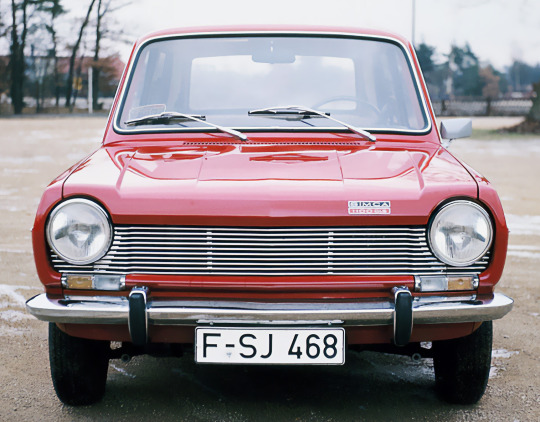

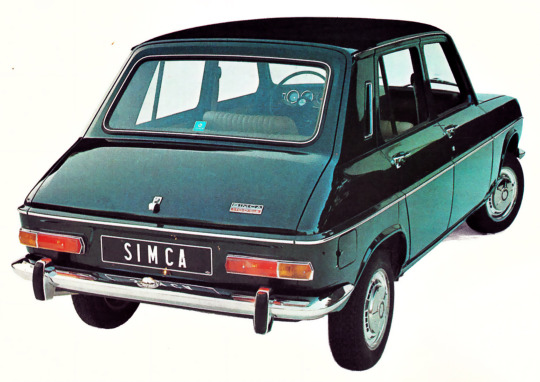

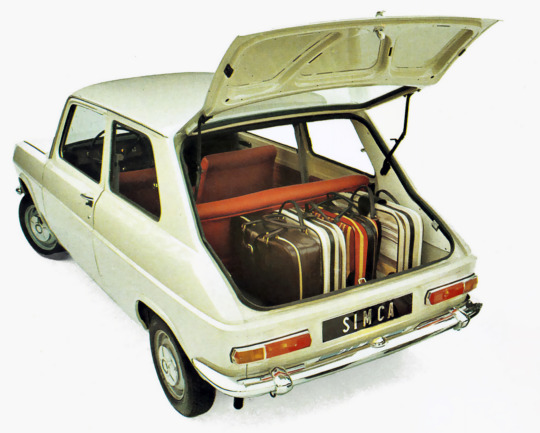
Simca 1100, 1967. Among the first unibody cars to offer the now industry standard transversely mounted engine and front-wheel drive, with all-around independent suspension, disc brakes and rack and pinion steering. The 1100 was an early mainstream hatchback with folding rear seats for maximum space utilisation and practicality. The car was an instant sales success across Europe and is said to have influenced Volkswagen's board who were contemplating the future of their mostly rear engined/aircooled model range. The 1100 refers to the car’s position within the Simca range rather than its cubic capacity, it was available with engines of 944, 1118, and 1294cc. Its success was a factor in influencing Chrysler to up their shareholding in the Société Industrielle de Mécanique et Carrosserie Automobile (Simca) to a point where they took full control of the company.
#Simca#Simca 1100#transverse engine#front wheel drive#hatchback#1967#1960s#C-segment#first of its kind#Chrysler#Chrysler Europe#dead brands
176 notes
·
View notes
Text

Early tank production at the Army Tank Arsenal. Photo courtesy Albert Kahn Associates
Detroit Arsenal Tank Plant
This tank arsenal was the first ever built for mass production of American tanks. When World War II erupted in Europe, and Germany began using tanks in its Blitzkrieg offensives, the United States did not have a tank production program. By mid-1940, the U.S. realized it needed an armored force separate from its infantry. In response to this need, the Detroit Tank Arsenal Plant sprang up seemingly overnight in the winter of 1940-'41, on 113 acres of farm land located north of downtown Detroit, in what is now the city of Warren. The mammoth structure measured five city blocks deep and two blocks wide, designed by master industrial architect, Albert Kahn, in the Moderne style. The main building, gigantic in size, was protected by 3-foot (0.91-meter) thick concrete walls against potential hostile bombardment.
Owned by the government and run by Chrysler, the plant received its first contract to build 1,000 M3 tanks in 1940. The government accepted the first M3 on April 24, 1941, while the plant was still under construction. The delivery was marked by a festive occasion, broadcast over a nationwide radio hook-up. VIPs and plant workers cheered as the tank fired its guns, smashed telephone poles, and destroyed a mock-up house. The plant also built M4 Sherman tanks, which have a turret mounted 75-mm gun. The plant set an all-time monthly production record by delivering 896 M4s in December 1942. As the war ended, the government suspended tank production.

During World War II, the Detroit Arsenal Tank Plant built a quarter of the 89,568 tanks produced in the U.S. overall. Its production closely matched tank production of either Great Britain or Germany. During the Korean War, the plant was modified to build the new battle tank, the M47 Patton. In all, Chrysler built 3,443 M47 Patton tanks between 1952 and 1954. During the '60s, the plant produced 500 of the superior M60A2 tanks, which had a novel turret mounted on an M60 chassis and featured a 152-mm gun launcher that fired both conventional rounds and a guided missile. In response to the 1973 Arab-Israeli war, the plant was producing a record five tanks per day.

In 1979, the Detroit Arsenal Tank Plant built components for M1 tanks, which were built at the Lima Art Tank Plant, and continued to build M60 tanks. Because the Lima Plant could not keep up the M1 production, the Detroit Tank Arsenal plant also began producing M1s for the army. In 1982, Chrysler sold the plant to General Dynamics, which produced both M60s and M1s until 1987. The plant was closed in 1996
Documentation includes the publication, Tanks and Industry, The Detroit Arsenal, 1940-1954,
Originally submitted by: Carl Levin, Senator
5 notes
·
View notes
Text
Red Alert - Chapter Twelve
Chapter Twelve: Domination
New York City
Day Twenty-One
There was no great parade when New York finally surrendered.
The Soviet infantry marched down Fifth Avenue in open order, fingers on their triggers. The great thoroughfare was grey and empty, dotted with the burned out remains of tanks and vehicles, the dead of both sides still scattered about. Those New Yorkers that hadn’t fled gazed warily from dark, broken windows - many of them were boarded up. Draft fliers and public information posters blew gently in the wind, and there was the distant sound of barking dogs, but all else was eerily quiet.
The men stole glances upwards at the ash-grey sky. The great skyscrapers were wounded by the fighting; the crown of the Empire State Building had been blasted away. The American International Building was a charred, blackened husk, as was the Rockefeller Centre, while the comparatively undamaged World Trade Centre towers looked worn and rundown. The Chrysler Building, now being converted to serve as General Cherdenko’s headquarters, was the only truly unharmed tower, and to some of the men it seemed almost a symbol of defiance.
As they passed the Metropolitan Museum of Art, they saw steely-eyed Chekists at the doors, fingers on the triggers of their battle rifles. No frontovik would be looting this esteemed establishment - that, it seemed, had been saved for the staff officers and KGB men that the infantry could see beyond the doors, laughing and dancing drunkenly around the precious art.
This was the great Soviet victory, then. It felt decidedly hollow. Too many men had died for this burned out ruin. Some thought they ought to have laid siege; they had enough port facilities in Philadelphia to keep the invasion going, didn’t they? The ones in New York had all been destroyed, and it would be weeks before they would be operational again. Was it worth so many thousands of good Russian men, they wondered?
It didn’t matter now. The Battle for New York had finally come to an end.
Now these men would be going inland.
------
Temporary United States Military Headquarters, Columbus
Day Twenty-Two
“So, uh, give it to me straight, gentlemen.”
Vice-President Carter wiped a bead of sweat from his forehead as he watched the generals around him - both in person and on screen - preparing their reports. The temporary command centre wasn’t bad, seeing as it had been hastily set up in a bunker under the Columbus City Hall - it had state of the art communications technology, connecting him with both the Liberty and the Western Command at Omaha. Carville was pacing next to the now obligatory ‘big map’ that had been laid out on a table in front of them. He was scowling, but then again, nobody had much to smile about these days.
Carville had been trying to insist the government decamp west for days - since Pittsburgh had fallen. Carter was having none of it. If the men were staying, then so was he. Even if many of the men of the shattered Task Force Banks weren’t staying, but were fleeing west as fast as they could. Somebody had to make an example, Carter thought. Somebody had to draw a line in the sand. Ohio would hold.
In any case, he knew he wasn’t really in command. That laurel belonged to the generals, now. The very thought made him shudder.
“Mr. Vice-President.” Carville opened for the generals. “We’ve got good news and we’ve got bad news. Which do you want first?”
“Uh… good news, I think,” replied Carter. “We could all do with some.”
Carville nodded to one of the generals on screen - the large, bald and muscular General Fuller, who insisted on wearing his combat fatigues at all time, Vice-President be damned.
“We’ve been squeezin’ their Seattle beachhead by the balls,” he said. “And they’re startin’ to squeal. I’ll give ‘em a week tops before they give in.”
“That,” added Analyst Jackson from his office aboard the Liberty, “has significant geopolitical implications. With Soviet nuclear forces concentrated against Europe, there may be room for the involvement of Japan and Korea in the war - to say nothing of Generalissimo Chiang.”
“Well, I mean, he’s barely better than the Soviets,” mused Carter.
“Better the devil you know, Mr. Vice-President,” said Jackson. “Or rather, better the devil you’ve funded.”
“So, we could assemble Japan, China and Korea into our ‘coalition of the willing,” said Carville. “And we may, as much as I hate to say it, have a breakthrough in Europe. Colonel?”
Colonel Hawthorne cleared her throat.
“I’ve been contacted by Mi6,” she said. “They’re telling me that if we can silence Soviet nuclear forces in Eastern Europe, they can send in forces to assist us.”
“It would be damn dicey, Mr. President,” said Carville. “But intelligence suggests it might work. We still have SAC squadrons available in Britain and Iceland.”
“And the V-Bomber force,” added Hawthorne.
“Our combined bomber strength might be enough to knock the Soviet missile launchers in Poland and the Baltic out of action,” continued Carville.
“But what about their strategic forces?” asked General Fuller.
“I’m not convinced Premier Romanov’s prepared to use them,” replied Granger. “Intelligence suggests…”
“I’m not risking nuclear war based on your convictions, General Granger,” said Carter firmly. “Jackson, what does our intelligence suggest?”
“Our overseas intelligence no longer exists, Mr. Vice-President,” replied Jackson. “Everything we have has either gone to ground or been lost. But consider this in purely economic terms, sir. Could the Russians afford the ships and aircraft needed to mount this invasion, and a dedicated psionics department, and prototypical Tesla weapons and heavy tanks, and still be able to afford upkeep for strategic weapons?”
“Are you willing to risk the world on it, Jackson?” asked Carter.
“With all due respect, Mr. Vice-President, we don’t exactly have a lot of options here,” said Carville.
“We could escalate-”
“We already made the decision to escalate,” snapped Carville. “We did so the moment President Dugan ordered a counterstrike. If we want to win this war, we have to accept the possibility that nuclear weapons are going to be used.”
Carter paled.
“I…”
He mopped his brow again.
“You may proceed with the operation,” he said, “provided you can show me detailed intelligence on their missile sites. I don’t want the first sign that we missed one being a mushroom cloud over London.”
“My British counterparts are already gathering a full report,” replied Jackson.
“Good, good,” nodded Carter. “Now, what’s the situation on the eastern front?”
------
Pittsburgh, Pennsylvania
Day Twenty-Two
The giant tower had been set up in a park in the middle of the city.
Khabarov frowned as the installation - this enormous cattle prod - was checked over by the engineers, his arms crossed. Zofia stood next to him, but her eyes were fixed on the newly minted General Demichev, who was shouting terse orders at anyone who would listen. He wore a new uniform, black in colour with purple trimmings, with a truly enormous peaked cap. One might almost have forgotten that, just a few weeks ago, the man had scorned the very concept of a PsiCorps.
“His hypocrisy is unbecoming,” Khabarov noted.
“He’s hardly the first officer to exchange principles for power,” noted Zofia. “Although I do wonder if a bit of fear might be motivating him.”
“Fear?”
“He wants to be on the right side,” said Zofia.
“The right side?” Khabarov raised an eyebrow. “The right side for what?”
“Just thinking out loud.”
“Comrade General.”
Khabarov turned. Yuri had walked up behind him, General Vladimir and Afina in tow. Even from several paces away, Khabarov could smell the alcohol on the general’s breath - he fought the urge to cringe. He couldn’t stand an officer who drank on duty - especially when they were meant to be the theatre commander.
“Comrade Yuri,” nodded Khabarov, “General Vladimir, sir.”
“Khabarov,” growled Vladimir.
“Premier Romanov has been kept informed of your work in Pennsylvania, comrade,” said Yuri. “He has asked General Vladimir to convey his most sincere congratulations. Hasn’t he, Vladimir?”
Vladimir looked like he had just sucked on a particularly sour lemon. He reached into his jacket, producing an envelope.
“It gives me…” he seemed almost to choke. “...immense satisfaction to inform you that you have been awarded the Order of Suvorov, Second Class, for your… exceptional performance in the capture of Pittsburgh.”
Khabarov looked down at the envelope. It was sealed in wax and bore Romanov’s signature, and he wondered why Vladimir had been asked to convey it. A quick look at Yuri’s face answered that question. This was party politics in action, and Yuri was looking to reward his friends - and humiliate his enemies.
“Thank you, Comrade General,” replied Khabarov, taking the envelope and offering his hand. “It is truly an honour to receive this award. I am sure you have been rewarded likewise?”
Vladimir huffed and shook his hand, turning a bright shade of purple.
“God damn you, you son of a bitch,” he hissed.
Khabarov smiled.
“Now,” declared Yuri. “Let us see this tower activated. We have a world to win, comrades, a world to win.”
He strode towards the tower, Vladimir spitting angrily into the grass before following him. Afina took her place next to Khabarov, who was looking back at the tower.
“You aren’t going with Comrade Yuri?” asked Zofia.
“Dignitaries only,” she replied evenly.
“Ah, our classless system at work,” nodded Zofia.
They gazed on - the tower began to glow purple, electricity dancing along the sides like a giant Tesla coil. Khabarov tasted electricity and metal in the air.
“Vladimir is an aberration.”
His eyebrows shot up, and he turned towards Afina.
“Comrade?”
“A classless system should not reward such mediocrity,” she continued, her voice still even, almost emotionless. “Such arrogance. It should not allow for men strutting around with chests covered in unearned medals, growing fat on the labour of the people.”
Khabarov snorted.
“That is the Soviet system, comrade,” he replied. “Some men are more equal than others.”
“Not for long.”
Khabarov turned, but Afina’s gaze remained directed towards the tower.
“Comrade Yuri believes in a true Soviet system,” she said. “One free of these oligarchs and Napoleons. One where every body, every mind and every soul is truly equal. A truly Marxist system under a truly Marxist intelligence.”
“A Marxist intelligence?” asked Khabarov. “Like a computer?”
“He calls it the New Soviet Mind,” said Afina. “Every human on Earth, connected by a single consciousness. There would be no war, no hunger, no strife. All would be one.”
“Like a hive mind?” Zofia interjected. “I read of it in a novel. One singular group mind?”
“Indeed,” said Afina. “No Romanov, no Khabarov, no Zofia, no Afina, no Yuri. Only Man.”
Khabarov pondered.
“Well,” he said, “Yuri dreams big. I respect that in a man.”
Afina nodded.
“It may not be possible,” she admitted, “but it is a nice thought.”
She walked away, tucking her hands behind her back as she went.
“You think she’s mad, Lieutenant?” asked Khabarov.
“I don’t,” replied Zofia, “and that’s what scares me.”
Khabarov nodded.
“Still,” he said, “her master will be a good ally against Vladimir, yes? And besides…”
He pointed to the beacon, which was now throbbing with psionic power.
“...you can’t deny it’s an exceptional weapon.”
------
The Liberty
Day Five
“...which would put Cherdenko in a position to threaten Albany. That, of course, depends on if he can muster the forces, which we believe is doubtful, considering issues with the Soviet logistic train in upstate New York…”
Hawthorne stood on the bridge, listening attentively to General Granger’s report in Columbus. The other officers on the bridge had allowed their attention to become distracted - Commodore Weathers and Biggs were whispering in the back of the room, while Eva was doodling at her desk. Even on the other end of the screen, they could see Carville lighting up a cigar while Vice-President Carter fought off the urge to doze off.
“...alright, Granger, you’re starting to talk yourself in circles,” said Carville at last.
“General Carville,” asked Hawthorne. “What’s our position in the south?”
“Hard to say, we haven’t been able to contact Louisiana in a while, but-”
There was an ear splitting ring, and the screen went dark.
“God damn it, are they jamming Columbus again?” demanded Weathers.
“I thought they hardened comms after last time,” grunted Eva.
“That’s the army for you,” sighed Biggs. “Looks like we just gotta wait until-”
A loud series of beeps filled the room, and white text appeared on the screen.
THIS IS AN EMERGENCY MESSAGE FROM THE PRESIDENT OF THE UNITED STATES.
“Dugan?” demanded Biggs. “What the fuck?”
The door opened - Jackson and his bald assistant raced into the room, the former almost pale.
“Colonel, we’re getting a lot of unusual encoded traffic,” said Jackson. “It’s coming straight in from the Joint Chiefs, and it’s General Carville’s personal cipher.”
“Do you know what it says?” asked Eva.
Jackson shot her a meaningful look.
“Right, CIA, got it,” nodded Eva.
“Only four-star generals or higher are authorised to read it,” continued Jackson. “It’s gone out to Omaha and all of our regional commands.”
“What does it say, Jackson,” demanded Hawthorne.
“No encore.”
“No encore? Can you translate that for those of us that don’t speak spook?” demanded Biggs.
“No encore,” repeated Jackson. “It means cease fire.”
“It means give up,” the bald man clarified. “War’s over.”
“What?!” demanded Eva.
“My fellow Americans.”
Hawthorne held up an arm to silence them as President Dugan appeared on the screen. The President was pale and seemed clammy, and Hawthorne couldn’t help but notice that his eyes appeared cloudy and unfocused.
“For the past few weeks, I have been in discussion with Premier Romanov about his special military operations,” he said. “He has made it clear to me that the Soviets forces that we, erroneously, saw as invaders, are in fact liberators.”
“Jesus Christ,” said Biggs.
“For the past two decades, rogue forces within our government and military have been controlling both the American state and the lives of the American proletariat for the benefit of a sinister cabal of businessmen. They seeked to privatise your lives and to enslave your minds. The Soviets are here to dismantle this evil system, and in doing so, liberate our hearts and our minds. It will take some time for them to do this; they will need to occupy our cities and towns to root out the enemy.”
“What the hell is this?” demanded Commodore Weathers.
“Mind control,” whispered Jackson.
“Ma’am!” exclaimed Eva. “Our comms are being jammed! I just lost Omaha!”
“Rogue elements of our military, I am afraid, are continuing to resist the Soviets,” continued Dugan. “I have only now been able to contact General Carville, and have ordered him to issue orders that all US commands surrender immediately. He has complied with this order. My Vice-President, who was conspiring to keep the conflict going, has been arrested. In time, when America has been pacified, our military, hand-in-hand with the glorious Red Army, will return to take its part in the peaceful Comintern alliance, and will expunge this evil from the rest of the world.”
“Can you raise Fuller?” demanded Weathers. “Or Pearl Harbor?”
“Negative, sir, I’m completely locked out!” exclaimed Eva. “We have no comms at this time!”
Hawthorne furrowed her brow.
“Until that time, rest peacefully in your beds,” said the President. “The Soviets are our friends. We are now free.”
He smiled, and his eyes did not match.
“The war is over.”
The screen went blank, and silence swept over the bridge. For a long time, Hawthorne stared at the black screen, seeing her own face reflected in the darkness.
“Well,” she said. “This complicates matters.”
2 notes
·
View notes
Text
Events 7.8
1099 – Some 15,000 starving Christian soldiers begin the siege of Jerusalem by marching in a religious procession around the city as its Muslim defenders watch.
1283 – Roger of Lauria, commanding the Aragonese fleet, defeats an Angevin fleet sent to put down a rebellion on Malta.
1497 – Vasco da Gama sets sail on the first direct European voyage to India.
1579 – Our Lady of Kazan, a holy icon of the Russian Orthodox Church, is discovered underground in the city of Kazan, Tatarstan.
1663 – Charles II of England grants John Clarke a Royal charter to Rhode Island.
1709 – Peter I of Russia defeats Charles XII of Sweden at the Battle of Poltava, thus effectively ending Sweden's status as a major power in Europe.
1716 – The Battle of Dynekilen forces Sweden to abandon its invasion of Norway.
1730 – An estimated magnitude 8.7 earthquake causes a tsunami that damages more than 1,000 km (620 mi) of Chile's coastline.
1758 – French forces hold Fort Carillon against the British at Ticonderoga, New York.
1760 – British forces defeat French forces in the last naval battle in New France.
1775 – The Olive Branch Petition is signed by the Continental Congress of the Thirteen Colonies of North America.
1776 – Church bells (possibly including the Liberty Bell) are rung after John Nixon delivers the first public reading of the Declaration of Independence of the United States.
1808 – Promulgation of the Bayonne Statute, a royal charter Joseph Bonaparte intended as the basis for his rule as king of Spain.
1822 – Chippewas turn over a huge tract of land in Ontario to the United Kingdom.
1853 – The Perry Expedition arrives in Edo Bay with a treaty requesting trade.
1859 – King Charles XV & IV accedes to the throne of Sweden–Norway.
1864 – Ikedaya Incident: The Choshu Han shishi's planned Shinsengumi sabotage on Kyoto, Japan at Ikedaya.
1874 – The Mounties begin their March West.
1876 – The Hamburg massacre prior to the 1876 United States presidential election results in the deaths of six African-Americans of the Republican Party, along with one white assailant.
1879 – Sailing ship USS Jeannette departs San Francisco carrying an ill-fated expedition to the North Pole.
1889 – The first issue of The Wall Street Journal is published.
1892 – St. John's, Newfoundland is devastated in the Great Fire of 1892.
1898 – The death of crime boss Soapy Smith, killed in the Shootout on Juneau Wharf, releases Skagway, Alaska from his iron grip.
1912 – Henrique Mitchell de Paiva Couceiro leads an unsuccessful royalist attack against the First Portuguese Republic in Chaves.
1932 – The Dow Jones Industrial Average reaches its lowest level of the Great Depression, closing at 41.22.
1933 – The first rugby union test match between the Wallabies of Australia and the Springboks of South Africa is played at Newlands Stadium in Cape Town.
1937 – Turkey, Iran, Iraq, and Afghanistan sign the Treaty of Saadabad.
1947 – Reports are broadcast that a UFO crash-landed in Roswell, New Mexico in what became known as the Roswell UFO incident.
1948 – The United States Air Force accepts its first female recruits into a program called Women in the Air Force (WAF).
1960 – Francis Gary Powers is charged with espionage resulting from his flight over the Soviet Union.
1962 – Ne Win besieges and blows up the Rangoon University Student Union building to crush the Student Movement.
1966 – King Mwambutsa IV Bangiriceng of Burundi is deposed by his son Prince Charles Ndizi.
1968 – The Chrysler wildcat strike begins in Detroit, Michigan.
1970 – Richard Nixon delivers a special congressional message enunciating Native American self-determination as official US Indian policy, leading to the Indian Self-Determination and Education Assistance Act of 1975.
1972 – Israeli Mossad assassinate Palestinian writer Ghassan Kanafani.
1980 – The inaugural 1980 State of Origin game is won by Queensland who defeat New South Wales 20–10 at Lang Park.
1980 – Aeroflot Flight 4225 crashes near Almaty International Airport in the then Kazakh Soviet Socialist Republic (present day Kazakhstan) killing all 166 people on board.
1982 – A failed assassination attempt against Iraqi president Saddam Hussein results in the Dujail Massacre over the next several months.
1988 – The Island Express train travelling from Bangalore to Kanyakumari derails on the Peruman bridge and falls into Ashtamudi Lake, killing 105 passengers and injuring over 200 more.
1994 – Kim Jong-il begins to assume supreme leadership of North Korea upon the death of his father, Kim Il-sung.
2003 – Sudan Airways Flight 139 crashes near Port Sudan Airport during an emergency landing attempt, killing 116 of the 117 people on board.
2011 – Space Shuttle Atlantis is launched in the final mission of the U.S. Space Shuttle program.
2014 – Israel launches an offensive on Gaza amid rising tensions following the kidnapping and murder of three Israeli teenagers.
2021 – President Joe Biden announces that the official conclusion of U.S. involvement in the War in Afghanistan will be on August 31, 2021.
2022 – Former Japanese prime minister Shinzo Abe is shot twice and killed while giving a speech in Nara.
4 notes
·
View notes
Text
Why Small Businesses Fail (Or Fail To Thrive)
So a person you know which right 2009 investment; or I should say correct 2009 Ipo? Your first step in order to find out what IPOs are available for purchase. This is easily produced by visiting the SEC's (Security and Exchange Commission) EDGAR website. Came from here you can search for company filings. What need to do here is look for S-1 filings. S-1 filings are the IPO's prospectus.
If they will not together with this information, we suggest you walk, no make that head for the hills. For people that do, in order to looking for positive growth trends and sales volumes. That's one indicator for selecting a growth company to partner with one particular measure of methods safe ignore the may choose to be. We don't recommend partnering with a company that's stagnant or declining in sales. It can actually also be pertinent mindful to possess a look at what happened with the trends throughout a recession. They will can survive and grow then, chances are they should be fairly long-standing.
In raising all on the money, I have now sold off ninety percent of the equity available. I am left owning 100 shares US business fillings just 10 percent of the actual. This is going to severely impact my physical, emotionally and overall motivational well to become. Slowly but surely, I 'm going to become very bitter. It my idea and I am doing all the work! It isn't fair that I only own 10 percent of small business!
The lender should never charge a fee in this service nor run a credit state they experience. If what canadian companies hire foreign workers insist on running your credit, hang up US corporation listings and the else. Inquiries on credit rating report that not result in a loan can reduce your credit rate. Wait until you decide who to work with. It's important to do not forget that this letter is No approval for a financial loan. data companies in usa has not even begun.

You are standing in that specific conference room next inside your counterpart from BSN, the largest food company in Europe, who is buying that business. US trademark database Sunlight rises behind the Chrysler building. Attorneys and bankers buzz concerning the room finishing last minute details. A waiter wearing a tuxedo wheels in a cart of champagne. Someone cups his hand over-the-counter mouthpiece of one's telephone and announces: "The money has moved." Champagne corks piece.
What become the search penalty fees? - A reputable patent attorney offer a cost estimate to one's patent shop. Be aware that fees start at $450 . so be sure must for a bid.
#online business directory#business listings#us corp database#free business lookup#US trademark lookup#corporation lookup db#find company information#company details#corporation details
1 note
·
View note